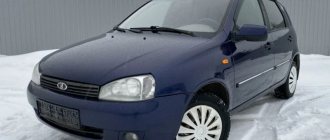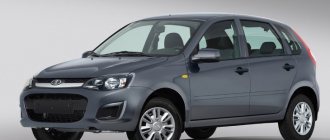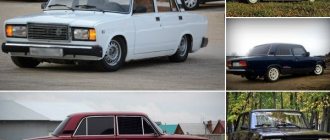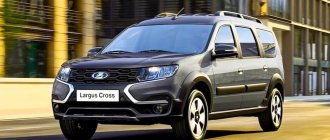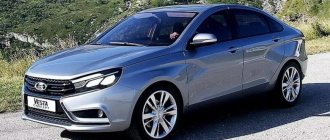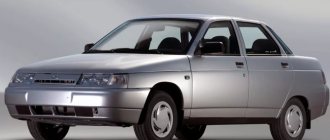The development of this car began back in 1993, and the first copies were shipped to customers only in 2004. In comparison with its predecessors, Kalina is already a modern car that had a fundamentally new design. The car received a new, improved 1.6-liter sixteen-valve engine, and buyers were offered several body styles, including a sedan, hatchback and station wagon. Subsequently, it was decided to abandon the Lada Kalina sedan, offering only station wagons and hatchbacks. The car was in good demand among buyers, lasting on the assembly line for 9 years, after which the second generation of Lada Kalina appeared.
Exterior
During almost 10 years of preparation for production, the design of the Lada Kalina was changed several times. Many car owners and experts note that in appearance the front part of the Kalina is vaguely reminiscent of the Volkswagen Golf, produced in the early 2000s. You shouldn’t expect any special refinements in Kalina’s appearance, but, in comparison with the previously produced VAZ classics, the new car has a truly modern design.
Interior
The interior of the first generation Lada Kalina, although somewhat improved compared to its predecessors, is still frankly outdated, losing to its main competitors, including budget Europeans and Koreans. The quality of the plastic used in the finishing does not stand up to criticism; soon after the start of use, the interior panels creaked mercilessly, and it was almost impossible to get rid of such crickets. Buyers were offered several color options for velor trim, and in top versions it was possible to get cars with headrests in the rear row of seats.
Photo Lada Kalina Drive Active
The Lada Granta and Kalina Drive Active cars are very reminiscent of sports versions of cars. Among the external differences are alloy wheels of reduced diameter. Inside the cabin, the only difference is in the finishing of the parking brake handles and gearbox. Drive Active cars also inherited the sports suspension from the “charged” versions. But the power unit and transmission remained without modifications.
Installed motors
Initially, the Lada Kalina was equipped with a 1.6 liter eight-valve engine developing 81 horsepower. In fact, it was a bored out 1.5 liter engine from a Lada Priora. The engine was quite economical and unpretentious, but one could not expect good dynamics from such a car. Soon, buyers were offered a more modern sixteen-valve 1.4-liter engine, developing a power of 89 horsepower. It was a fairly economical power unit, which consumed 7 liters in the combined cycle, and at cruising speed outside the city about 5 liters per 100 kilometers. The top modifications also offered a 98-horsepower sixteen-valve engine, which was not very popular among car owners because the timing belt on it often broke.
Confusion and vacillation
The NEW engine is not the only change in Kalina. Both the 1.4- and 1.6-liter versions of the car received a modified chassis. In particular, barrel-shaped springs began to be used in suspensions instead of conical springs. On small bumps, small coils located at the edges of the spring work, and on large potholes, large, central coils come into play.
The changes are obvious - on the broken Karelian roads the car shook very tolerably. The car copes well with potholes - even when the wheels fell into a decent hole, the suspension “punched” extremely rarely. But small irregularities - cracks in the asphalt, chips in the road surface - are clearly noticeable.
As for handling, it is still far from ideal. If there are potholes in a turn, the rear of the Kalina begins to noticeably “walk” along the road. And the rolls are too big.
Prices and options
Lada Kalina was offered to customers in Standard, Norma, and Lux trim levels. As it was on the assembly line, the list of basic and optional equipment on this car was constantly expanding. If initially air conditioning and parking sensors were available only in the luxury configuration, then later they were offered to be installed on the Norma configuration for an additional fee. Some versions of Kalina received a standard audio system and other options that provide driving comfort and improve the safety of the driver and passengers. For the first time on VAZ cars, power steering was already used as standard on Kalina, which made it much easier to control the car at low speeds.
The first generation Lada Kalina station wagon, which appeared in 2009, was very popular among buyers. This car, despite its small dimensions, had a spacious trunk, and the rear seats could be folded down, easily transporting large items in the cargo compartment. The Luxury trim received not only air conditioning and parking sensors, but also an airbag for the driver, as well as an anti-lock braking system. This modification was equipped with a powerful 1.6-liter engine, but only a manual transmission was available.
The cost of the first Lada Kalina was about 200 thousand rubles, and for top modifications they asked for 220-250 thousand rubles. Subsequently, the list of standard equipment only expanded, the price invariably increased, which rose to 300 thousand rubles. With such an initially low cost, the car was in good demand on the market, especially since its maintenance was not difficult, and most of the service work and repairs were carried out by car owners themselves.
Advantages of Lada Kalina
Car owners generally spoke positively about the first generation Lada Kalina, noting its efficiency and good reliability. The car was offered at an affordable price, which was significantly lower than that of inexpensive European and Korean cars of similar class. The advantages also include low operating costs; spare parts for the Lada Kalina cost pennies, and many of the jobs could be done yourself without contacting a service center.
At the beginning of the 2000s, Lada Kalina was a significant step forward in terms of cabin soundproofing. Compared to its predecessors, the new car was significantly quieter, including at high speed. The new car had a roomy interior, especially for the hatchback and station wagon versions.
The 1.6-liter carburetor engine, simple in design, did not cause much trouble for car owners; it could be overhauled independently, critical breakdowns were extremely rare, and the service life was about 200 thousand. The same applies to the chassis, which, although it was quite rigid, was durable and trouble-free to maintain.
The lineup
To be honest, the second generation Kalina is not a completely new model. This is nothing more than the result of a deep restyling of the first generation car, which debuted in 2004. Many changes were made to the design, which also affected the reliability of Kalina 2. The problem of unpredictable breakdowns, due to which many people ignore AvtoVAZ products, was practically solved.
Lada Kalina 2 station wagon
Lada Kalina 2 hatchback
The “second” Kalina model range consisted of a hatchback and a station wagon. Subsequently, on the basis of the latter, an all-terrain version of Cross was created, differing from the original by increased ground clearance and a modified appearance. Kalina Cross is most popular in the secondary market. Kalina is supported by the fact that this model is assembled using modern equipment, thanks to which the notorious human factor during assembly is practically reduced to zero.
Lada Kalina is painted using an automated complex. So you won’t be able to find fault with the quality of the painting. However, on used copies it is better to monitor the condition of the enamel. It is better to touch up deep scratches and chips. Owners of Kalina will not have any major problems with corrosion, but additional anti-corrosion protection will still not hurt a domestic car.
Disadvantages of the first generation Lada Kalina
Many car owners spoke negatively about the quality of the body metal, which began to rust even in the absence of visible damage, scratches or chips. There were numerous problems with the electrical system, which was not very reliable, and numerous electronic sensors often malfunctioned and required replacement.
Another weak point of this car is the injection engine, which often failed, after which it was necessary to diagnose the injection and repair the fuel system. The weak stove deserves special criticism, as it could not heat the car interior in winter even after 15-20 minutes of driving.
One could not expect good dynamics from a car with an engine power of 80-90 horsepower. The car clearly lacked power both on the highway and when accelerating in the city from traffic lights. Cars with high mileage could also experience problems with the cooling system, which led to frequent engine overheating in hot weather.
10.03.2021
Lada Kalina II generation (2013-2018)
VAZ Kalina is a five-door station wagon belonging to class “B”. Thanks to the graceful contours of the body, the car has a modern, elegant look, has an improved interior design and original lighting technology compared to its predecessors. The VAZ Kalina car is quite maneuverable and easy to operate and maintain. The body design of the VAZ Kalina fully meets modern safety requirements, and thanks to the developed internal space, the car interior can easily and comfortably accommodate 5 people.
Story
Lada Kalina I generation (2004-2013) Lada Kalina II generation (2013-2018) Lada Granta FL from 2018
The first generation LADA KALINA was launched into production in 2004. First, the sedan saw the light, and in the fall of 2006, sales of a five-door hatchback began. A station wagon was added to the range of modifications in the spring of 2007. LADA GRANTA – this is how the five-door car began to be called after the last restyling. The design of the front part of the body is made in the new corporate style
Engine
At the beginning of sales, Kalina had only an 8-valve 1.6-liter engine with an output of 81 hp. with index 21114. This is a new modification of the 2111 engine with a volume of 1.5 liters, familiar to owners from the “ten”. Unlike its predecessor, the Kalinovsky engine lost the problem of valve bending due to a broken timing belt. However, the valves themselves can burn out by 50,000 km; they must be periodically adjusted manually, since there are no hydraulic compensators.
Later, the 8-valve engine was joined by 16-valve 1.4- and 1.6-liter units. “Junior” (11194) can still bend the valves if the timing belt breaks - there are no grooves for the valves in the pistons. Therefore, do not delay the replacement and periodically check the belt tension, fortunately this is not difficult. The belt is usually changed with a tension roller, and every other time - together with the water pump.
On the “older” engine of this family (21126), the problem with bent valves is also relevant, and the timing belt must be monitored and changed in time. In general, the service life of belts on Kalina is 60,000 km, but the experts unanimously advise changing them at 50,000 km.
If any of the “engines” starts to misfire, most likely the problem is in the ignition module or spark plugs. But if the car’s speed starts to fluctuate when cold, then a clogged throttle is most often to blame. The second and third places in the ranking of culprits are occupied by the idle speed controller and the sensor of the throttle valve itself.
At risk are ignition coils, thermostats and generators, oxygen sensors (but 1900 rubles) and mass air flow (from 2800 rubles). The clutch lasts an average of 100 thousand km, but can fail after 20,000 km due to disc wear. However, it is better to update the entire mechanism with the basket and release bearing.
If the engine stops heating the interior, and the operating temperature is indecently low - 99%, the fault is with the dead thermostat, which is “stuck” in the open position and drives the coolant in a large circle through the radiator. Dealers are forced to change the oxygen sensor at 75,000 km.
Transmission
The box, even though it howls and does not please with the clarity of switching, runs for quite a long time, and on weaker engines (for which it was designed) its service life will be longer. The clutch can last up to 100,000 km, it all depends on which manufacturer the kit is installed in the box. At this mileage, the gearbox lever seals and its small plastic rod bushings usually wear out.
Suspension
The Lada Kalina suspension is simple in design, energy-intensive and generally durable. Sometimes the electric power steering fails - turning off the ignition helps.
If we average the data we received and exclude the installation of cheap “China” ones, then by 50,000 – 75,000 km the shock absorbers and wheel bearings will have to be changed “in a circle”. At 100,000 km, the silent blocks of the levers and ball joints usually die. The levers themselves can last up to a respectable 150,000 km.
Knocks in the steering rack may appear as early as 50,000 km, but there is no need to panic here; on Kalina, the rack can be easily repaired and most often it just needs to be tightened.
Body and interior
The body became stronger and received a double-sided galvanic coating. Although assembly flaws do occur: moldings often come off even on new cars, glass sits too loosely in the doorways and rattles! while driving, and some body elements have uneven gaps. In the cabin, the flimsy glove compartment lid is annoying, seated on the “snot” and with a gap as thick as a finger. The mood will also be spoiled by the warped upholstery of the A-pillars, the roof lining sagging in some places and the heated windows not working.
Among the little things, it is worth noting the washer reservoir, which is located under the hood so that when driving over holes and potholes, it hits the body and cracks over time, as well as the fuse box, which is located behind the external lighting control unit. To get to the fuses, you need to remove this block and very often during this operation its latches break off.
Electrical equipment
It is difficult to judge the reliability of electrical equipment in a used Kalina, as well as the suspension. Original blocks and relays often malfunction, light bulbs burn out with enviable regularity, and you are unlikely to find spare parts installed at the manufacturer in a 5-7 year old version.
Not all is well with the car's electrical equipment. Light bulbs often burn out, power windows and central locking malfunction, and the dashboard lights go out. The body electronics control unit fails (RUB 8,000). The multimedia system constantly freezes, which is why the owner is deprived of music and navigation. The multimedia system freezes, causing the owner to lose music and navigation. In 2014, AvtoVAZ, together with the supplier, released a new version of the firmware for multimedia. But it was still not possible to completely cope with the eccentricities of the system.
The original generator usually “dies” after 3 years of service. One of the troubles is the engine control unit, which is located under the heating radiator. A leak in the stove - and replacement of the unit is guaranteed.
But the motors are, by and large, reliable. There are three of them on Kalina, all 1.6-liter gasoline: an 8-valve with a capacity of 87 horsepower, as well as 98- and 106-horsepower 16-valve engines.
On all engines, the valve cover leaks with age. Repairs cost pennies - just install a new gasket or seal the lid. The timing belt is prescribed to be changed every 75,000 km, but mechanics recommend thinking about updating it after 50,000 km. It is advisable to change the water pump (2,500 rubles) at the same time as the timing belt - it usually fails after 100,000 km. The fact is that a leaking pump can jam and then cut off the teeth on the driven belt. If such a malfunction occurs with a 16-valve engine, then a major overhaul of the engine is guaranteed.
In a five-speed manual transmission, the second gear synchronizers wear out earlier than others. This problem, only in a more severe form, was still present on VAZ cars of the tenth family. Heredity plays a role. But the Jatco 4-speed automatic transmission is a priori problem-free. You only need to change the oil in the gearbox once every 60 thousand km.
ENGINE
On all engines, spark plugs and ignition coils, oxygen sensors (1,900 rubles each) and mass air flow sensors (from 2,000 rubles) periodically fail. Often the ECU engine control unit malfunctions, causing the engine to suddenly stall and refuse to start again. Over the years, the crankshaft and camshaft oil seals begin to leak.
SUSPENSION
The suspension of the Lada Kalina is simple in design - MacPherson struts in front, semi-independent accordion in the rear. The chassis as a whole is energy-intensive and durable. At risk are the rear wheel bearings (1,600 rubles each), which begin to howl after 50 thousand km. But the front ones last twice as long. The remaining parts last a long time.
BODY
The body is given a factory 6-year warranty against through corrosion. On the one hand, it's very good. On the other hand, some specimens of “Kalina” may bloom with rusty spots after the second Russian winter. And not only characteristic body elements, such as wheel arches and sills, but almost all parts - doors, hood, fenders and even the roof. This happens sometimes.
ELECTRICAL
Failures in electrical equipment occur quite often. The climate control unit may become depressed, the electric motor of the wipers may fail, or the lamps in the lighting fixtures will burn out with enviable frequency. The dashboard lights may suddenly go out. But most importantly, on most cars the multimedia system constantly glitches and freezes.
ADVANTAGES AND DISADVANTAGES
+ Completely reliable engines and gearboxes, excellent maintainability. cheap spare parts, low cost of ownership, energy-intensive suspension. – Unstable quality of spare parts, poor sound insulation, poor body protection against corrosion.
